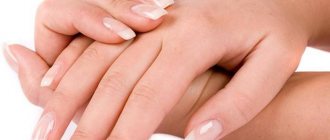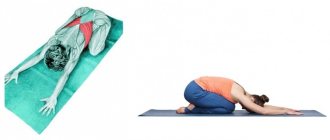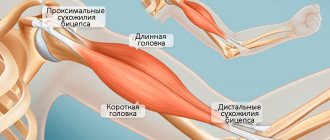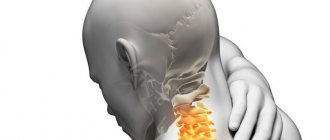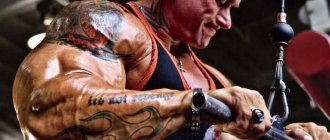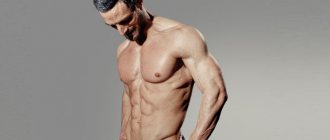Finger exercises are rarely included in general training programs. Meanwhile, strengthening this area is advisable not only for people actively involved in sports, but also for those who want to remove fat in this area.
The muscles of the fingers are located only on the side of the palms and are represented by the muscle groups of the thumb and small finger.
The first group forms the eminence of the thumb on the hand, and the second forms a tubercle on the inside of the palm. Training these areas can not only strengthen the muscles and develop the phalanges, but also relieve fatigue and pain in the hands.
Regular training of your hands and fingers will give them graceful shape and flexibility in just a couple of weeks.
Why do this?
In most cases, this is not an extreme necessity, but a desire to make the fingers more aesthetically attractive. One has only to look at the hands of musicians, especially pianists, their fingers are thin and long. But you shouldn’t think that all musicians are born with just such fingers - this is the result of their professional activity. This means that anyone can adjust the length and thickness of their fingers.
There are a lot of tips on this matter, among the most popular and effective:
- Playing musical instruments.
- Embroidery and knitting.
- Massage. It is the simplest of all methods, as it does not require too much time and material costs.
- Special exercises.
The shape of the fingertips and the character of a person.
What does the shape of your fingers indicate?
- Square fingers. Such a person does not like to fly in the clouds and is aimed at achieving material well-being. They are often ossified in their beliefs; you should not expect surprises from them. Their negative qualities include boredom and boringness. But at the same time, these people know how to set goals and achieve them.
- Cone shape. Inherent in an emotional, idealistic person. To work productively, he requires a friendly atmosphere and warm relationships in the team. He loves to engage in self-development. As a leisure activity, he often chooses to visit the ballet and museums, as well as trips to unexplored places.
- Pointed shape. A sensitive person who often comes up with creative ideas. Unfortunately, it is not always possible to implement them. The owner of this finger shape truly loves power and can become a leader in any team. Having become a leader, he will be stern but fair.
- Drop-shaped fingers. It speaks of human sacrifice, the desire to help everyone. If you turn to him for help, you will never receive a refusal from him. He has an innate sixth sense, so it will be very difficult for even an experienced fraudster to deceive him.
- Shovel-shaped. A person is in a constant pursuit of new, unknown sensations. The reasons for his depressed state include routine and boredom. He loves to change his environment and hobbies. Often distrustful, stubborn and knows how to stand out from the crowd. A suitable profession for him is either related to art, or one where he can constantly be on the road.
Exercises to lengthen your fingers
A whole set of exercises is designed to stretch, improve flexibility and strengthen the fingers. The first thing you need to do is warm up your fingers, to do this you should stroke each finger from tip to base, make movements as if you were washing your hands.
Stretching
This is the next stage of gymnastics, it is carried out in the following steps:
- Take your finger by the base and extend it as far as possible. Hold in the extended position for about 15 seconds, then release. Do 20 repetitions for each finger.
- Grab your finger lengthwise and twist it. Also hold in this position for 15 seconds. Thus, twist all fingers 10 times clockwise and counterclockwise.
- Grab your finger by the nail phalanx and pull 20 times. Repeat with all fingers in turn.
- Make finger tilts left and right, 30 repetitions for each.
- Bend and straighten each finger 40 times.
- For the last stretching exercise, you will need a book; it should be placed in the center of a table or other flat surface. Place your hands on the table, with your thumb going over the edge, and with the rest you need to reach for the book for 10-15 seconds. After this, relax your hands by shaking them and repeat 4 more times.
Flexibility
This complex consists of the following stages:
- Place both hands on the table and alternately lift each finger. In this case, an important condition is that each finger is raised one at a time, all the others must be pressed to the table.
- Next is an exercise for the entire hand. One palm needs to be relaxed, the other should press on it, pulling it back. So stretch each palm in turn. Between approaches, relax your hands, as if shaking water from your hands.
- Another exercise is to roll a small ball between the fingers of each hand in turn. At the same time, do not help yourself with your other hand. You can do this exercise without any limit on the number of approaches and anywhere.
Strengthening
These exercises are the final ones in the complex for lengthening the fingers, consisting of the following actions:
- Clench your fist 40 times for each hand.
- Fall onto the wall using your fingers.
- Do push-ups on your fingers.
Why does deformation of fingers occur?
Traumatic injuries
The following injuries cause deformation of the fingers:
- Injury.
The finger swells and there is moderate pain on palpation and movement. All symptoms gradually disappear after 1-2 weeks. - Fracture.
The change in shape is associated with swelling or displacement of fragments. In the latter case, shortening and axial curvature are detected. The pain is intense, the function of the hand is sharply reduced, sometimes crepitus and pathological mobility are detected. - Dislocation.
The finger is severely deformed in the joint area, movements are impossible. Severe pain syndrome is noted. - Subcutaneous tendon rupture.
Occurs when the end of a finger (usually the index finger) hits a hard surface. The distal phalanx bends, the finger takes on a hook shape, and active extension is impossible. - Frostbite.
Due to significant swelling, the fingers become sausage-shaped, and the hand sometimes resembles a pillow. Intense burning pain is observed.
Arthritis
Deformation of the fingers in the early stages occurs due to swelling, and subsequently due to destruction, erosion and fibrosis of the articular ends of bones and cartilage tissue. Features of the clinical picture are determined by the type of arthritis:
- Rheumatoid.
Most often, the metacarpophalangeal joints of the 2nd and 3rd fingers are affected; multiple arthritis is possible. The lesion is symmetrical. Involvement of distal joints is uncommon. - Psoriatic.
The defeat is asymmetrical. All joints of the finger are involved in the inflammatory process, which resembles a sausage due to swelling. The skin over the joints is purple-bluish. - Gouty.
The joints of the hands become inflamed more often in women. Possible oligo- or polyarthritis. The course is paroxysmal, intense pain is combined with swelling, hyperemia, and increased local temperature. - Juvenile rheumatoid.
Diagnosed in children under 16 years of age. The localization of inflammation is the same as in ordinary rheumatoid arthritis. - Nonspecific infectious.
It occurs in the form of polyarthritis. The deformity appears some time after an acute infection, is caused by edema, quickly disappears, and the osteochondral structures are not affected.
Arthrosis
Post-traumatic arthrosis affects one joint and can occur at any age. Changes gradually increase over several years, and deformation forms in the later stages. Multiple arthrosis of the hands and fingers develops in patients of the older age group, and is more often observed in the presence of a hereditary predisposition or during professional activities involving heavy load on the hands.
A special sign of arthrosis are Heberden's and Bouchard's nodes. The former are formed in the area of the distal interphalangeal joints, the latter - in the proximal ones. Heberden's nodes are often accompanied by lateral deviation, aggravating the deformity. With Bouchard's nodes, the fingers become fusiform due to thickening. There is a symmetrical lesion involving 10 or more joints.
Deformation of fingers
Developmental anomalies
Congenital malformations of the fingers can occur in isolation, combined with other stigmata of embryogenesis, or observed as part of syndromic pathologies:
- Ectrodactyly.
One or more fingers are underdeveloped. Due to the median splitting, the hand often resembles a crab claw. - Syndactyly.
There is complete or partial fusion of the fingers with each other. The shape and size of the fingers can be preserved (simple form of the disease) or changed (complex syndactyly). - Brachydactyly.
One or more phalanges are shortened. A combination with syndactyly, rotation of the phalanges around an axis, changes in the shape of the nail plate, and underdevelopment of the metacarpal bones is possible. - Polydactyly.
The patient’s hand has additional full-fledged, bifurcated, or vestigial fingers. - Clinodactyly.
The fingers are curved, the axis of the fingers does not coincide with the axis of the hand. The disorder is symmetrical, affecting the little or little fingers and ring fingers. - Arachnodactyly.
The fingers are long, thin, characteristically curved. The deformity is combined with other skeletal changes and, as a rule, is part of syndromic pathologies: homocystinuria, Marfan syndrome, ectopic lens, dissection and dilatation of the aorta.
Hereditary syndromes
Finger deformities are observed in a large number of diseases caused by random mutations, aneuploidies, and genetic abnormalities. Alternation or combination of several defects is detected in the following syndromes:
- Andersen's syndrome:
brachydactyly, clinodactyly, sometimes syndactyly. - Cornelia de Lange syndrome:
syndactyly, clinodactyly, reduction in the number of fingers. - Poland syndrome:
syndactyly, brachydactyly on the affected side. - Kabuki syndrome.
It is distinguished by particularly pronounced polymorphism. Brachydactyly, syndactyly, arachnodactyly, clinodactyly are possible.
There are a number of hereditary diseases that are characterized by one specific congenital anomaly of the fingers:
- Clinodactyly
. Affects the little fingers of the hands and is observed in cry-the-cat, Russell-Silver, and Down syndromes. - Brachydactyly
. Found in diastrophic dysplasia, Aarskog-Scott and Noonan syndromes. - Syndactyly
. Identified in patients with Pfeiffer syndrome. For Van der Woude syndrome, a combination of syndactyly with underdevelopment of 1 finger is typical, for Apert syndrome - partial or complete fusion of 2, 3 and 4 fingers, possibly with one common nail.
In patients with Fanconi anemia, the absence or underdevelopment of the thumb is determined, in patients with Rubinstein-Taybi syndrome - congenital expansion of the phalanges of the fingers, especially the first. In other cases, deformities are not observed from the moment of birth, but are formed during the patient’s life:
- Ollier's disease.
Acquired enlargement, thickening due to the growth of cartilage tissue. - Thiemann's disease.
Asymmetrical aseptic necrosis of the phalanges of 2-3 fingers. There is a fusiform thickening, then shortening of the distal phalanges, deformation of the interphalangeal joints. - Progeria.
Deformations are caused by early aging of the body, the development of osteoarthritis - Mucopolysaccharidosis.
The first symptom of the disease is acquired flexion contractures. - Friedreich's ataxia.
Disturbances in the shape of the hands are associated with paresis and muscle atrophy. - Pseudohypoparathyroidism.
The phalanges shorten and bend due to the destruction of bone tissue.
Hypertrophic pulmonary osteoarthropathy
GLOA (Marie-Bamberger disease) develops in many chronic inflammatory and oncological diseases. The nail phalanges take on the shape of “drumsticks”, the nails become like “watch glasses”. GLOA is more often detected in patients older than 40-50 years. Possible reasons are:
- Neoplastic processes
: peripheral lung cancer, esophageal cancer, thyroid cancer, lymphogranulomatosis, mediastinal sarcoma, pleural mesothelioma, metastases to the mediastinum. - Diseases of the lungs and pleura
: pleural empyema, lung abscess, chronic pneumonia, bronchiectasis, fibrosing alveolitis. - Cardiac pathologies
: infective endocarditis, “blue” heart defects. - Gastrointestinal diseases
: nonspecific ulcerative colitis, Crohn's disease, chronic hepatitis, primary biliary cirrhosis.
Sometimes changes occur with cystic fibrosis and hyperthyroidism. There is also pachydermoperiostosis (primary hypertrophic osteoarthropathy), in which similar hand deformities are caused by an autosomal recessive hereditary pathology, and are not caused by severe disorders of the internal organs.
Other reasons
Other possible causes of symptoms include the following:
- Felon.
Significant swelling is noted; in deep forms, the outcome is often severe deformities caused by bone defects and joint damage. - Syringomyelia.
The fingers thicken, the skin becomes dry and rough. - Chinga.
Initially, the deformity is provoked by swelling of the joint, which may result in osteoarthritis and ankylosis. - Chondroma.
Often occurs in the area of the phalanges. Grows slowly over several years. - Rickets.
Thickening of the interphalangeal joints (“strings of pearls”) is detected. - Paresis, paralysis
. The fingers become deformed due to disturbances in innervation, atrophy, and the predominance of traction of some muscle groups over others.
How to make your fingers thinner?
In other words, how to lose weight in your fingers. Of course, such local weight loss is impossible; in order for your fingers to not look like sausages, you need to lose excess weight. If everything is fine with your weight, but your fingers are still far from graceful, especially swollen, then you should visit a doctor; perhaps there are pathologies of the internal organs, in particular the kidneys and excretory system.
Often fingers become plump if a person leads a sedentary lifestyle, that is, fat accumulates in the fingers. Often the visual effect of thick fingers is created by wrinkled skin; in this case, exercise alone will not correct the situation; you need to take special baths and moisturize the skin of your hands. A daily massage from the tip of the finger to the base will help.
Diagnostics
Determination of the pathology that causes deformation of the fingers is carried out by orthopedic traumatologists. According to indications, patients are referred to rheumatologists, surgeons, neurologists, and other specialists. The most commonly performed diagnostic procedures are:
- Questioning, inspection
. During the conversation, the doctor establishes the time and circumstances of the occurrence of the symptom, and identifies other disorders. Explores the dynamics of disease development. Determines the nature and severity of external changes, the presence of edema, skin color and temperature, joint mobility. - Radiography
. Pictures of the fingers or hand are taken in two projections. Radiographs visualize dislocations, fractures, disturbances in the configuration of the phalanges, neoplasms, signs of inflammation and degeneration, and areas of bone melting. - , MRI
. Recommended when X-ray examination is insufficiently informative. They allow you to detail the identified changes, accurately determine their location, nature and volume, choose the optimal tactics of conservative therapy, and plan surgical intervention. - Lab tests
. Required to confirm hereditary diseases, oncological and inflammatory processes, rheumatic diseases.
The examination plan for secondary osteoarthropathy depends on the characteristics of the underlying pathology. During the diagnostic process, chest X-ray, ultrasound of the abdominal organs, echocardiography, and other techniques may be prescribed.
Surgical correction of finger deformities
Nutrition
It can also make your fingers thinner and also help you lose weight. To do this, you need to follow the following recommendations:
- Eat less salty sweets, as well as foods that make you want to wash it down with water.
- You need to drink clean water, and not replace it with coffee, tea, juices, and especially sweet sodas.
- Minimize consumption of fatty and fried foods.
- Include vegetables, herbs, cereals, fish, and mushrooms in your daily diet.
- You should try to eat freshly prepared food and certainly not semi-finished products.
Conclusion. Fingers simply must be beautiful and well-groomed, especially for women. There is such a designation as “musical fingers”, which confirms that thin and long fingers are beautiful and therefore many strive to lengthen them using the above exercise technique.
Character by fingers on the hand - their location
Tells about the nature of the location of the fingers relative to the palm. Pay attention to the border between the palm and fingers, their bases. If a straight line is formed, the person is distrustful, selfish, does not like to listen to other people’s opinions and will not help unselfishly. Anyone who dares to start a relationship with him will have to forget about his own interests.
For a person who constantly doubts, the border is shaped like a triangle. The individual doubts the fidelity of a loved one, the correctness of his own decisions, and suffers from many complexes and uncertainty. The business partner will cancel the deal at any time.
The arcuate border indicates the golden mean. He is a calm, balanced and confident person. A reliable, good spouse, a good business partner, with whom you will be satisfied with cooperation.
The ability to read character on your fingers is useful. Having seen a person’s hands, they understand what to expect and whether to trust the person. Determining character by the fingers is a simple skill that can be mastered at home.
Determining the sources of the problem
Most often, women notice swelling after they stop fitting their favorite ring. After this, of course, I want my fingers to lose weight. At the same time, you need to understand that it is important to exclude pathological conditions that cause such a strange symptom. For example, edema often occurs as a reaction to malfunctions of the kidneys and reproductive system. In addition, be sure to exclude diseases of the thyroid gland and heart.
The easiest way to fight banal obesity. Extra pounds settle on the body in different ways. For some women, the waist disappears and the “loin” increases. It happens that limbs get hit. Determining the need to lose weight is not difficult. There are many online calculators that allow you to determine the correct body index and assess the need to lose weight.
